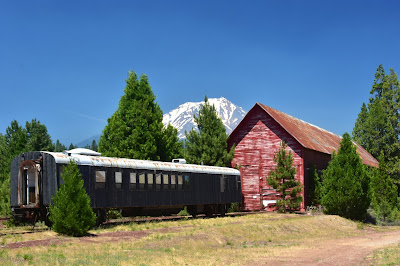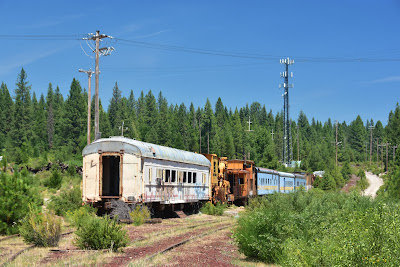Our camp last night at the KOA in Klamath Falls turned to be pretty pleasant. We didn't get full hookups, but this morning the trip to the dump station went smooth as silk, and we were soon on our way. From Klamath Falls we trusted Ms. GPS to guide us to Route 97, which she did unflaggingly, much to our surprise. Well, she did tell us to stay in the left lane all the way through old town, but had we done that we would have ended up going the wrong direction when we got to Route 97. Thankfully, at the last moment we figured it out and moved over one lane to save the day and our continued sanity.
For the most part we cruised south on Route 97 past most farm fields all the way to Weed, California. We did pass through the "town" of Worden, Oregon, which probably should be called a village. It did appear they had a museum of sorts there, but we didn't stop since we wanted to put some miles on the clock.Since we didn't stop anywhere except one roadside rest, we didn't do much in the of photography. Thankfully, our terminus this afternoon turned out to be McCloud, a town that was once a favorite of ours in northern California
Once upon a time a fabulous tourist railroad ran from McCloud to Mount Shasta, California. Before the tourist railroad, the trains had been used in the lumbering industry. Here's some information on this fabulous line that I found at https://www.american-rails.com/mccloud.html:
Most often railroads like the Southern Pacific, Santa Fe, and interurban Pacific Electric Railway are regarded as California's best remembered such companies. However, another sometimes forgotten legendary system was the McCloud River Railroad (reporting marks, MCR), a logging line operating in the state's timber rich northern region. It was established in 1897 by lumber mill interests who were looking to move their finished product as quickly as possible to market and with a nearby connection to the much larger Central Pacific (then an SP subsidiary), a railroad seemed quite logical.During the railroad's peak years it owned a system stretching nearly 100 miles and while it was built to move timber and it also operated as a standard common carrier shipping whatever freight was available (and for more than 50 years also dispatched passenger trains). As timber demand declined the railroad slowly cut back although new ownership also led to its downfall. It closed in 2009 and the property is now for sale as a rail/trail as of 2012.
During the second half of the 19th century, and particularly with the completion of the Transcontinental Railroad in the spring of 1869, California began booming. With a demand for construction and materials and the rich timber regions located to the state's north it was not long until companies began moving in.One such business was owned by George Scott and William Van Arsdale. By the 1890s they already were operating sawmills on the western slope of Mount Shasta with connections to the CP/SP whose main line to Oregon passed through the area. However, there were no more locations here to continue expansion so they looked east on the other side of the mountain. With no direct rail service, however, any mills they built would also need a new railroad. In 1896 they purchased a bankrupt mill from Friday George in the area and converted a former streetcar/interurban line into a heavy freight railroad.
By late 1896 about four miles of track was opened and a connection at the town of Mt. Shasta with the CP. On January 21, 1897 the McCloud River Railroad Company and the McCloud River Lumber Company were formed, both operated and owned by the same individuals.Interestingly, Van Arsdale and Scott stuck around only long enough to see the operation during its earliest years as they sold their interests in 1902. By 1905 the railroad was completed to McCloud and continued to expand eastward, further into rich timber reserves. By 1920 the system had expanded beyond Bartle and its main line now stretched more than 35 miles. Additionally, as with most logging lines it was also building miles of temporary spurs to tap various tracts of pine timber. These short branches were shoddily built and were only meant to be used briefly before being torn out and the track relaid elsewhere.
From a corporate standpoint, the McCloud River Lumber Company divested itself of the railroad in 1917 to avoid any antitrust issues with all of shares handed over to the shareholders. The system continued to march westward after 1920. It reached more timber via a branch to the recently created town of Pondosa and the biggest feat to occur during that decade was a connection to another major Class I, the Great Northern at Hambone.The GN had recently completed its "Inside Gateway" project with the Western Pacific where both lines established a connection with one another at Bieber, California. Being so close to the McCloud River and its heavy timber/lumber traffic, GN constructed an extension from Lookout (just north of Bieber) to reach Hambone (the WP would also have trackage rights over this branch, which essentially gave the McCloud River Railroad yet another major interchange partner).
At this point the MCRR operated exactly 47.0 miles of track from Mt. Shasta to Hambone, which did not include all logging spurs and general sidings. During the 1940s and 1950s the railroad grew for the final time. It took over a former roadbed south of Bartle once used by Pacific Gas & Electric and by 1955 had reached Burney with a branch to Sierra.It also shifted its route to Pondosa using this line and abandoned the other branch reaching the small town. The McCloud River Railroad's new line south of Bartle was thanks to a new customer, the Fruit Growers Supply that needed wooden shipping crates to move its produce. Unfortunately, 1963 spelled not only the end of the MCRR's growth but also signaled the beginning of its decline.
That year it was acquired by US Plywood and since it was no longer locally owned, the national wood products company began severely cutting back operations. It ended nearly all rail timber rail movements, shifting these to trucks. As such, nearly its only remaining traffic became finished products such as plywood and lumber from mills at McCloud, Pondosa, and Scott.
In 1969 the line was sold again to U.S. Plywood-Champion Papers, and two times in the 1970s, Champion International in 1972 and Itel Corporation in 1977. During this time, however, the railroad still operated much of its original system that spanned 77.9 main line miles between Mt. Shasta, Hambone, and Burney. On July 1, 1992 it was sold for a final time to 4-Rails, Inc. owned by Jeff and Verline Forbis who renamed the company as the McCloud Railway. It was also during the 1990s that the MCRR fell on hard times. It lost its interchange and Hambone, losing paper traffic. By 2005 it only operated about 16.8 miles of main line between Mt. Shasta and McCloud, despite the fact that shippers remained east of McCloud. The final hammer fell in 2009 when the entire property was shuttered, even the once popular Shasta Sunset Dinner Train that had been operating the route to McCloud for a number of years. In early April, 2012 it was announced that the entire property was looking to be sold to a non-profit group and turned into a rail/trail. And there you have it. Yet another wonderful old railroad has become a moldering derelict. It looked to me as though workers were busily piling things up for the scrappers. I hope the cars don't get scrapped, but I have to guess that someone would really have to fall in love with any of the old equipment before they would be willing to pay to transport it to their property.If you're traveling around in your RV a truly great thing to do is find yourself one of the tourist railroads and take a ride before it too is gone. And when you go, we wish you exciting destinations and memorable travels from the Davises, the Happy Wanderers.











No comments:
Post a Comment